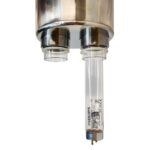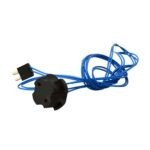What are UV-C rays
The small part of electro-magnetic spectrum having wave lenghts included between 100 and 400 nm (thousandths of micron) is defined as space of the ultra-violet irradiation. The UV-C are part of the subspace characterized by the wave lenghts included between 100 and 280 nm.
For being effective in the disinfection, an electro-magnetic wave, besides being of certain kind (L=254 nm) it must possess also a minimum value intensity to be able to ensure a minimum dose to water.

A uv sterilizer, if correctly sized, is able to give water a dose sufficient for reducing almost all the commonest micro-organism present in water.
Applications
The uv system can be used
– with well water (always recommend to perform some analyses of the well water to be able to verify the typology and the
quantity of present bacterial position)
– for residential use with reverse osmosis system and microfiltration system

– for industrial use

Benefits
– UV-C acts instantly (without any stocking tank)
– compatibility with the other technologies (filtration, reverse osmosis, softening etc…)
– environmental treatment (without addition of chemicals)
– does not change the water taste
– praticalness
– low capital and operating cost
– easy to operate and maintain
Uv system 110 watt features
– AISI 304 stainless steel body with pedestal
– In / out 1″ M
– Max pressure: 10 bar (145 psi)
– Ultraviolet radiation: 30.000 W/cm2
– Flow rate filtered water: 76 LT/MIN. (20 GPM)
– Flow rate osmotized water: 90,72 LT/MIN. (24 GPM)
– Power supply: 2 power supply with schuko plug x 200-240V 50/60Hz 0,25A
– Rating power: 143W.
– Philips average lamp life: 9.000h. – max. 1 year
– 2 Philips uv lamp 55 watt with 2 pins cap base G13
– Dimensions (mm.): L. 965 x Ø 108
– Drain valve included



































